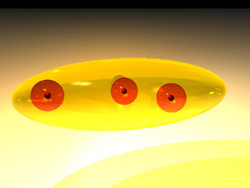Giant Ions Invade BECs

If physics had a sideshow, the latest addition would surely be this: bacterium-sized ions. According to new theoretical results, normal ions dropped into a Bose-Einstein condensate (BEC)–an ultracold gas in its quantum mechanical ground state–could seed the formation of micron-wide charged shells of atoms, or “molecular ions.” These objects, described in the 26 August print issue of PRL, could serve as moveable microtraps for atoms or aid in testing condensed matter theories.
Whenever a gas gets sufficiently cold, ions attract a crowd by polarizing surrounding atoms–inducing a charge asymmetry in them–which draws them near. Experimenters have already seen electron bubbles and ion blobs, or “snowballs,” in superfluid helium, but its high density seems to prevent large shells from forming around ions. In a normal cold gas, an ion might slowly accumulate atoms, but collisions would disrupt the cluster before a bubble could form.
Now a team of theorists calculates that the process should proceed more rapidly and be more stable for ions swimming in a BEC. As polarized atoms careen towards an ion, some invariably collide. Some of the collision energy can be channeled into a collective shudder of the condensate called a phonon. Such collisions can sap enough energy from an atom that it drops into orbit around the ion. As atoms accumulate, they repel each other and expand like a balloon. Collisions within the bubble should eventually drain the atoms’ energy and collapse them into a blob. The collapse would probably take at least a millisecond, says co-author Robin Côté of the University of Connecticut in Storrs, time enough for several hundred atoms to grow into a shell at least a micron wide, if not larger.
Ions might be introduced with a laser set just a bit higher than the ionization energy of a BEC, or by simply combining a cloud with an ion trap, Côté says. Researchers could accelerate the shells with an electric field and detect them based on their speed. A strong enough field might even yank them free of the atom cloud, so they could be isolated and allowed to evolve or used to transport atoms. What’s neat about the molecular ion is “it makes a bridge between condensed matter physics and atomic physics,” says Côté. It might be used to check condensed matter theories, for example. “Whenever you have a new system, it’s new physics, and it’s a lot of fun.”
Experimentalist Steven Rolston of the National Institute of Standards and Technology in Gaithersburg, Maryland, expects an ion trap might be necessary to keep stray electric fields from punting the bubble free but says that wouldn’t be hard to engineer. In pure physics terms, the phenomenon “seems to be a further example of the breadth of the physics that is coming about from BECs, much more than anyone anticipated.”
–JR Minkel
JR Minkel is a freelance science writer in New York City.


